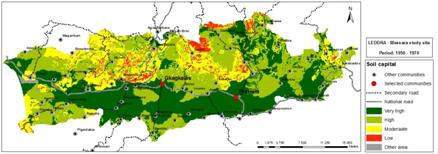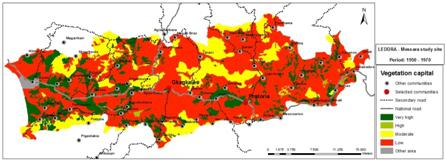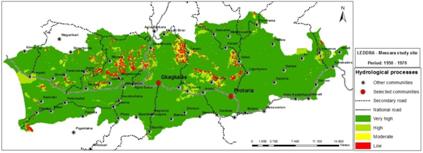Study sites in cropland
Study sites in grazing land
Study sites in forests
Cereal modernization period (1950 to 1970)
| Authors: | Aikaterini Kounalaki, Mina Karamesouti, Eleni Briassouli, Minas Metaxakis, Vassilis Detsis, Thanasis Kizos, Theodoros Iosifides, Alexandros Kandalepas |
| Coordinating authors: | Constantinos Kosmas, Giovanni Quaranta |
| Editors: | Alexandros Kandelapas, Jane Brandt |
Editor's note 20Mar14: Source D132-2.2.
Assessment of natural, economic and social capitals
| Natural capital | |
| Assessment | During this period soil capital in Messara is generally high and very high. Soils are deep or very deep soils (soil depth greater than 100 cm), and generally flat (slope gradient 0-6%), classified mainly as Cambisols or Fluvisols.
The main water resources are the two aquifers in the bottom valley and some springs located in the valley walls. The total water quantity is estimated to be up to 555 Mm³ and is of high capital value.
The dominant classes of vegetation capital are low and moderate, covering 62.0% and 19.8% of the total area, respectively. Such areas are mainly covered with complex cultivation patterns of annual crops (annual and perennials) or complex patterns of annual crops and natural shrubby vegetation. Very high class of vegetation capital covers 16.9% of the total area representing mainly olive groves or vineyards. There is moderate climate capital (88%) during this period, possibly attributed to high aridity. The western part of the valley, along the coast, has lower climate capital due to lower annual rainfall and higher aridity. |
| Critical functions | Regulation of hydrological processes (assessed by estimating surface water runoff). Areas of low hydrological regulation processes (infiltration rate lower than 70%) are mainly located in the northern part of the valley with the steepest slopes. The lower part of the Messara Valley has a high or very high ability to regulate hydrological processes (infiltration rate over 85% covering more than 95% of the total area).
Surface energy balance: More than 62% of the Messara Valley has a low surface energy balance, due to cereals providing limited plant cover during the summer months. Soils under cereals are almost bare, adversely affecting surface energy balance. Moderate and high surface energy balance covers almost 37% of the total area and are mainly covered with olives, vines, or natural shrubby vegetation. Primary production. Relative production for cereals, vines, and olives (measured production over maximum production defined for the area in kg/ha) is significantly related to soil depth, with production higher in the lowlands, for all crops. |
| Critical variables | Environmental fast and slow variables are soil depth (slow variable) and land use change (fast variable). Soil depth decreases slightly, mainly in the hilly areas. Expansion of olives at the expense of cereal cultivation is the major land use, expanding from 18.2% of total land area during the late 1950s to more than 38% in 1974. |
| Economic capital | |
| Assessment | Produced capital: Rural Crete continues to depend on the primary sector and the subsistence economy. Rural migration peaks in the 1960s. Tourism gradually emerges.
Financial capital is in short supply, with limited bank credit. Limited exports, remittances from migrants and gradually the tourism economy begins to provide cash. Landesque capital: infrastructures for cereal processing are important. Modernisation of infrastructures for olive processing is limited. Irrigation technologies are largely absent. Physical capital is limited to few and small olive mills and cheese making units. While internal transport infrastructure is minimal, significant improvements are made to the port and airport of Heraklion. Schools are located in the bigger settlements. Technology: Some mechanisation (tractors) is already evident since the 1960s. Animal (livestock), plant and forest capital is characterised by the gradual shift from arable land to olive plantations. |
| Critical functions | Critical economic functions are the lack of credit and the limited available cash. Linkages with the social functions, including extended family networks, dominate. |
| Critical variables | Produced capital in the form of agricultural production (mainly annual crops) is a fast variable, typically changing annually, depending on climatic conditions. Physical capital remains a slow variable, gradually picking up pace towards the end of the period. Landesque capital and plant capital show slow and gradual change as olive plantations replace cereals, accompanied by a gradual change in available technology (irrigation). |
| Social capital | |
| Assessment | There is a small decline in demographic capital. Out-migration increases towards urban centers of Greece, as well as other countries of northern Europe.
Human capital, in the form of formal education is extremely low. Informal human capital, however, is strong: production is based on local practices and arrangements with minimal mechanisation and market relations. Cultural, social and institutional capital (slow variables) is strong, centered around the family unit and kinship-based social networks. Institutional, political and decision-making structures and very centralized and follow a top-down approach |
| Critical functions | The most important critical functions are related to the pervasiveness of bonding social networks based on kinship (extended families) and the christening of children (koumparies). |
| Critical variables | Social variables are slow and ultimately depend on pervasive social networks based on kinship (extended families) and the christening of children (koumparies) |
The main LEDD problems and responses
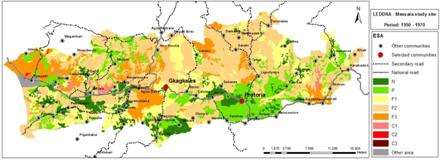 |
Soil erosion is a problem for hilly areas in the northern part of the valley and largely absent in the lowland or in sloping areas with adequate vegetative cover. Areas with nil annual erosion rates (lower than 0.5 t ha-¹ year-¹) cover 84.4% of the total. Land desertification begins to emerge as problem as more than 70% of the area is sensitive to desertification. |
The main responses are
- Land use change from cereals to perennial crops (mainly olives and vines). Olive grove expansions is favoured not only by climatic conditions and the olive trees' minimal requirements but also the massive rural migration. Vines on the other hand require much more active engagement on the part of farmers and expand to a lesser degree. Land use change as a response generally has positive effects on critical ecological functions: hydrological regulation improves due to the decrease in surface water runoff and recharging of ground water aquifers increases. Surface energy balance also improves.
- Traditional farming persists among the remaining farmers during the period with positive results due to sustainable management at the household level in order to ensure long-term self sufficiency. In sloping land the tradition of ploughing parallel to the contour lines (10-15 cm depth) and only when the soil has specific moisture conditions, helps prevent problems.
- Burning cereal straw emerges as a negative response during the second half of this period, increasing in parallel with mechanization as the presence of straw creates problems to ploughing tools.
Policy context
AK: to check that implementation, impacts and effectiveness of selected policies are discussed in this text. Look at D142 to see if there is any additional information.
Policy implementation takes place in the context of post-WWII reconstruction and the struggle of the central government to solidify its power over regional interests; and the aftermath of the Civil War (1945-1949), culminating in the military dictatorship of 1967-1974. Growth during the period is kick-started through external assistance and significant investment in electrification, telecommunications, water and sewage works as well as an expanding education system.
Main policies in effect are development policies focused primarily on the growth of tourism through support to transport (ports, airports) and cultural (museums, archaeological excavations) infrastructure. While tourism within the Messara Valley is limited, the rapid growth of Heraklion and the northern coast of Crete brings about the growth of several related industries such as construction, transport and services which provide significant sources of employment and pluri-employment for rural populations. Modernization efforts in the agricultural sector include FAO's region-specific Study of Water Resources and their Exploitation for Irrigation in Eastern Crete (published in 1969-1972) much of which is centered around irrigation of the Messara plain and, in particular, the area around Tympaki. The results of the programme, including assessment of available water resources, proposals for the Faneromeni reservoir, groundwater extraction, irrigation networks and proposals for olive tree and vegetable cultivation, are put on hold after the 1973 oil crisis to be continued in the 1980s, when financing becomes available through various EU policy instruments. Centrally implemented policies begin to support cereal production in the larger plains of mainland Greece, also undermining Messara's productive structure. The limited scale and application of these policies prevent their functioning as drivers of or responses to LEDD during this period. However, the continuation of these policies in the following decades, did give rise to LEDD problems.
Properties of the system
AK: to check if there is any further relevant information in D133
Robustness of natural capital (assessed based on soil characteristics and the vegetation cover type) is generally low: any severe lack of rain water during the growing period results in disappearance of cereals. The lower part of the valley has much higher robustness due to the presence of deep soils cultivated mainly with perennial crops. Diversity of land cover is relatively low. Redundancy is generally moderate: the farming economy is based on a mixture of cropland cultivation (various crops) and husbandry. Cropping systems in the area are moderately connected: cereal production is tightly connected to husbandry and fields with spare olive trees are connected to vine cultivation.
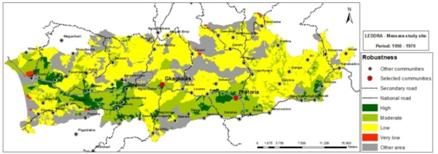
Concerning the openness of the system, nutrient fluxes are estimated to be extremely limited in the beginning of the period but growing steadily as fertilizer industries grew elsewhere in Greece, providing relatively cheap fertilizers. The rise in the importance of olive oil exports also opens up the nutrient cycles. If the rapidity of the ecosystem to respond to disruption is considered with regard to natural disaster such as fire, cereals can fully recover in one year but olive trees require at least three or four years for full recovery.
The economy of the area is characterized by a strong degree of subsistence. Farming is the dominant occupation of most households in the area although a certain degree of openness for a part of the products (mostly cereals) can be ascertained, pluri activity is widely practiced. In this sense, the system can be characterized by a high degree of redundancy. For diversity, non-monetised economic activity offsets the dominance of the agriculture sector.
Social capital of the area is characterized by these powerful kinship networks, based on extended families and the christening of children (koumparies), with far reaching political and economical influence. Messara farmers maintain such networks with shepherds of the Asteroussia or Psiloritis mountains moving livestock into the plains during the winter. These transhumance networks provide networks with localities outside the geographical limits of the plain, mostly the bridging type of social capital. Demographically, a smaller decline in population (especially compared to other similar rural areas in the region and Greece in general) indicates rather limited out-migration, but the population ages.
Socio-ecological resilience
AK: to be added, source: D133
Socio-ecological fit of the dominant response to LEDD
AK: to be added, source: D133

